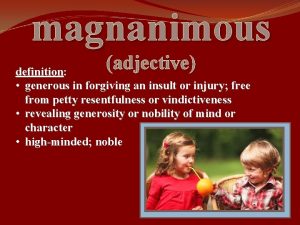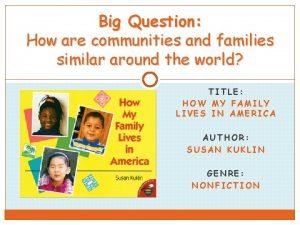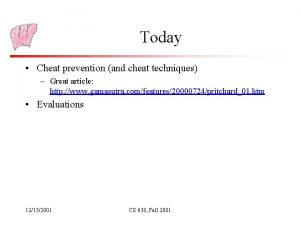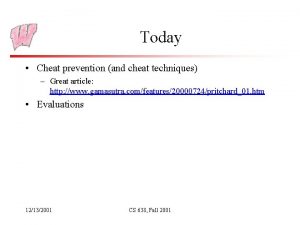Magnanimous Monday 1 cheat exam swindle 1 a





- Slides: 5

Magnanimous Monday 1. cheat : exam : : swindle : ______ 1. a. criminal b. business c. crook d. crime 2. 2. habit : custom : : extravagant : ______ 1. a. miserly b. extraordinary c. lavish d. crazy 3. actor : stage : : surgeon : : ______ 1. a. patient b. hospital c. operating room d. knife 2. 4. sun : day : : moon : ______ 1. a. dark b. night c. stars d. blackness 5. finger : nail : : leg : ______ a. arm b. torso c. knee d. walk

Teachable Tuesday Pick up your need to know at the front of the room, complete, and glue in your bellwork notebook.

Warm-hearted Wednesday Guide to Finding Native Australian Animals Many animal species are native only to Australia. The country is known for a very unusual mammal order commonly called monotreme. What makes a monotreme? Monotremes are distinguished from other mammals because they lay eggs. Like all mammals, they have fur or hair and nurse their young with milk. They are the most primitive group of mammals. Monotremes are more closely related to reptiles than to other mammals. After the young hatch from eggs, they are fed milk through pores in the mother’s skin. Australia and the neighboring island of New Guinea are the only places where monotremes live. There are only two members of this mammal group: the echidna and the platypus. When the first platypus specimen was taken to Great Britain, it was so unusual that many scientists thought it was a 1. In paragraph 2 of the first column of Monotremes, what does the word “distinguished” mean? A. smart B. set apart C. formal D. grew up 2. How does the author of “Guide to Finding Native Australian Animals” achieve his or her purpose? A. by describing the unusual features of the animals at each sanctuary B. by providing interesting facts about Australian wildlife C. by describing experiences the reader might have at each sanctuary D. by providing directions to popular animal sanctuaries

Thorough Thursday What the Moon Does 1 Moon dances. It sways across black sky, Spins in unison with Earth, Twirling together in time 5 So that we never see its back, Only its pale, serene face. Moon attracts. It reaches with arms of gravity, Tries to gather Earth near. 10 It calls the oceans closer, Causing high and low tides with the Persistent lure of its pull. Moon resists. We have visited it, 15 Stepped on its surface, Left footprints where No wind blows them away. But nobody owns the Moon glows. 20 It shimmers soft and white Despite being dark and rocky, With no inner light of its own. But sun shines a spotlight on Moon, Making it the center of attention 25 In every night’s performance. 1. Which stanza best captures the graceful nature of the Moon? A. stanza 1 B. stanza 2 C. stanza 3 D. stanza 4 2. How does stanza 3 contribute to the impression of the Moon created throughout the poem? A. It offers a different image than the first two stanzas, which present images of balance between Earth and the Moon. B. It introduces negative aspects of the Moon that are described in detail in stanza 4. C. It offers an image similar to the image in the other stanzas, which present physical descriptions of the surface of the Moon. D. It develops a relationship between Earth and the Moon that is introduced in stanza 2. 3. What is the effect of the imagery at the end of the poem? A. It suggests that the sun is jealous of the Moon. B. It shows that the Moon dominates the night sky. C. It tells why the Moon cannot be seen during the day. D. It emphasizes that the sun is brighter than the Moon.

Factitious Friday Friendship by John Dorr Rekindling old friendships Is finding lost treasure; It’s hard to place value Or even to measure. The people we meet And tuck neatly away Come back to our center And help light our way The trick now before us Is keeping them fresh, Or might we be tempted To lay them to rest. The people we’ve met And loved with our hearts Deserve our attention And fresh daily starts. 1. Based on the language and details in this poem, what can the reader infer about the speaker? A. The speaker fears that friends will move away B. The speaker values long-term friendships. C. The speaker has trouble forming lasting friendships. D. The speaker enjoys playing tricks on friends. 2. What type(s) of figurative language do you see in the poem?









